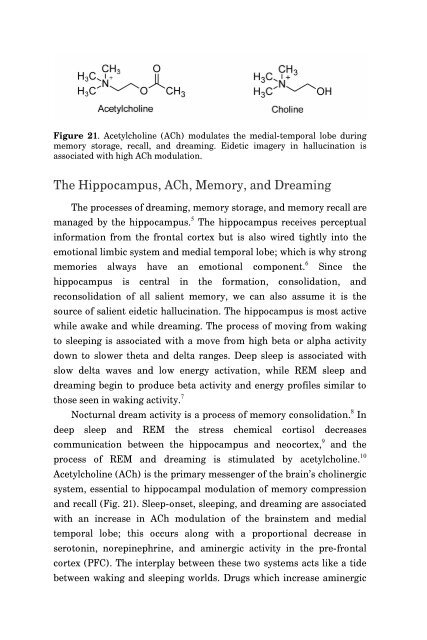Psychedelic-information-theory-Shamanism-in-the-age-of-Reason
Psychedelic-information-theory-Shamanism-in-the-age-of-Reason
Psychedelic-information-theory-Shamanism-in-the-age-of-Reason
- No tags were found...
You also want an ePaper? Increase the reach of your titles
YUMPU automatically turns print PDFs into web optimized ePapers that Google loves.
Figure 21. Acetylchol<strong>in</strong>e (ACh) modulates <strong>the</strong> medial-temporal lobe dur<strong>in</strong>gmemory stor<strong>age</strong>, recall, and dream<strong>in</strong>g. Eidetic im<strong>age</strong>ry <strong>in</strong> halluc<strong>in</strong>ation isassociated with high ACh modulation.The Hippocampus, ACh, Memory, and Dream<strong>in</strong>gThe processes <strong>of</strong> dream<strong>in</strong>g, memory stor<strong>age</strong>, and memory recall areman<strong>age</strong>d by <strong>the</strong> hippocampus. 5 The hippocampus receives perceptual<strong><strong>in</strong>formation</strong> from <strong>the</strong> frontal cortex but is also wired tightly <strong>in</strong>to <strong>the</strong>emotional limbic system and medial temporal lobe; which is why strongmemories always have an emotional component. 6 S<strong>in</strong>ce <strong>the</strong>hippocampus is central <strong>in</strong> <strong>the</strong> formation, consolidation, andreconsolidation <strong>of</strong> all salient memory, we can also assume it is <strong>the</strong>source <strong>of</strong> salient eidetic halluc<strong>in</strong>ation. The hippocampus is most activewhile awake and while dream<strong>in</strong>g. The process <strong>of</strong> mov<strong>in</strong>g from wak<strong>in</strong>gto sleep<strong>in</strong>g is associated with a move from high beta or alpha activitydown to slower <strong>the</strong>ta and delta ranges. Deep sleep is associated withslow delta waves and low energy activation, while REM sleep anddream<strong>in</strong>g beg<strong>in</strong> to produce beta activity and energy pr<strong>of</strong>iles similar tothose seen <strong>in</strong> wak<strong>in</strong>g activity. 7Nocturnal dream activity is a process <strong>of</strong> memory consolidation. 8 Indeep sleep and REM <strong>the</strong> stress chemical cortisol decreasescommunication between <strong>the</strong> hippocampus and neocortex, 9 and <strong>the</strong>process <strong>of</strong> REM and dream<strong>in</strong>g is stimulated by acetylchol<strong>in</strong>e. 10Acetylchol<strong>in</strong>e (ACh) is <strong>the</strong> primary messenger <strong>of</strong> <strong>the</strong> bra<strong>in</strong>’s chol<strong>in</strong>ergicsystem, essential to hippocampal modulation <strong>of</strong> memory compressionand recall (Fig. 21). Sleep-onset, sleep<strong>in</strong>g, and dream<strong>in</strong>g are associatedwith an <strong>in</strong>crease <strong>in</strong> ACh modulation <strong>of</strong> <strong>the</strong> bra<strong>in</strong>stem and medialtemporal lobe; this occurs along with a proportional decrease <strong>in</strong>seroton<strong>in</strong>, norep<strong>in</strong>ephr<strong>in</strong>e, and am<strong>in</strong>ergic activity <strong>in</strong> <strong>the</strong> pre-frontalcortex (PFC). The <strong>in</strong>terplay between <strong>the</strong>se two systems acts like a tidebetween wak<strong>in</strong>g and sleep<strong>in</strong>g worlds. Drugs which <strong>in</strong>crease am<strong>in</strong>ergic


